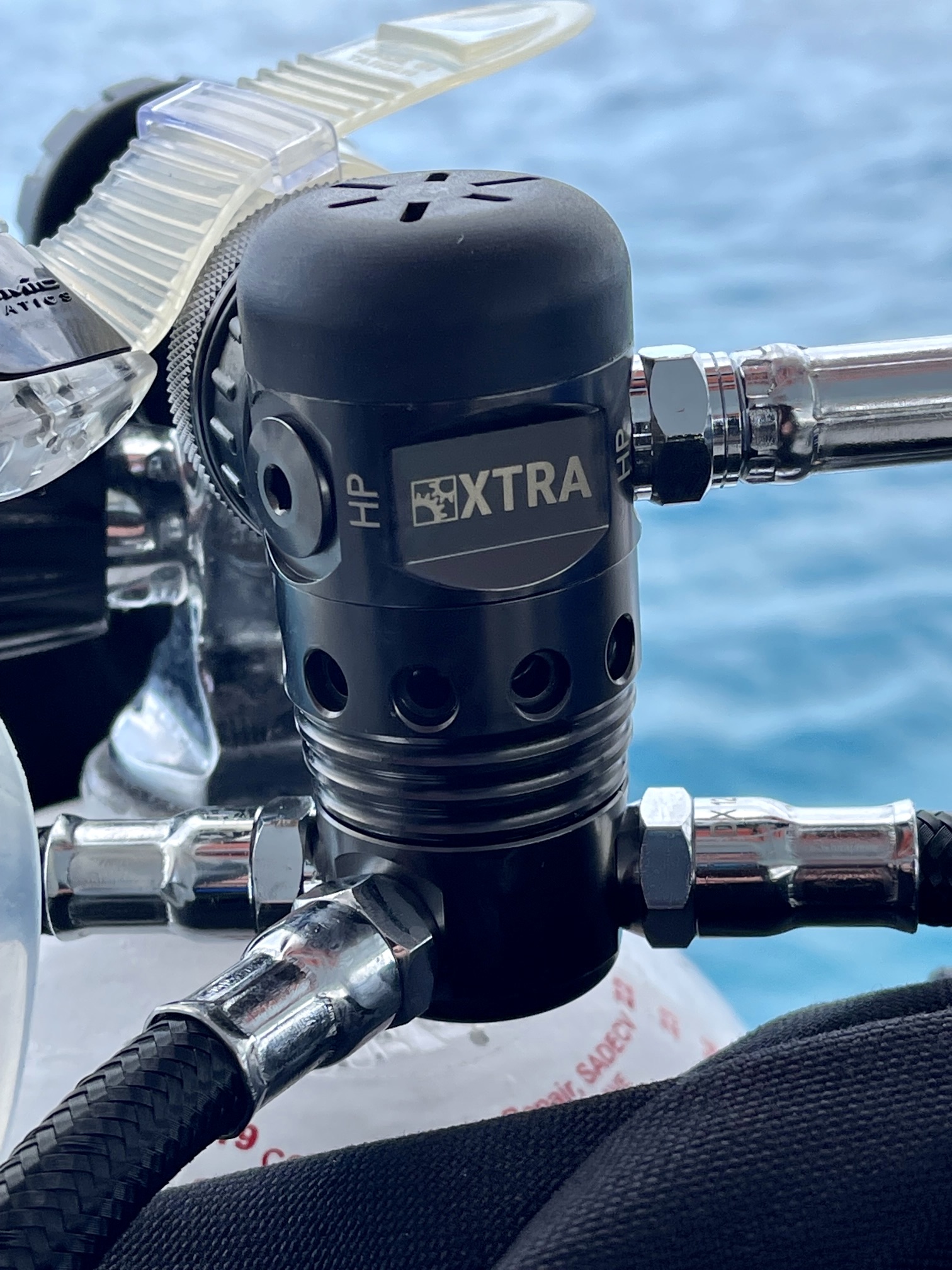Most Reliable Scuba Regulator
What’s the most reliable scuba regulator? Every diver wants to know—including me. I think the best qualified people to ask are the technicians that work on scuba regulators all the time. I am going to attempt to answer the question based on a mix of personal experience and the advice and opinions of several of my dive buddies who happen to be dive gear technicians.
That said, reliability can mean different things depending on what diver you ask. For example, diving in Lake Tahoe can mean exposure to temperatures as low as 39ºF. In that environment, the most reliable scuba regulator is one that resist free-flow due to freezing.
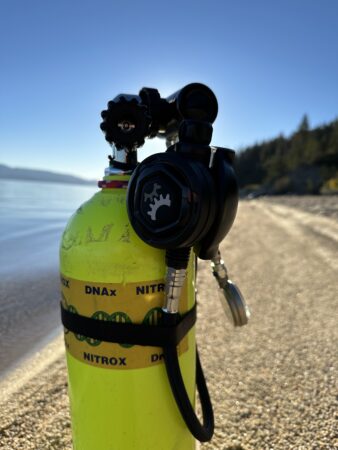 On the other hand, diving in remote locations with limited access to fresh water for rinsing gear poses a completely different reliability problem. As instructors, we tell our students all the time to rinse your gear, especially your regulator, before salt water has a chance to dry. Very often, that’s simply not practical.
On the other hand, diving in remote locations with limited access to fresh water for rinsing gear poses a completely different reliability problem. As instructors, we tell our students all the time to rinse your gear, especially your regulator, before salt water has a chance to dry. Very often, that’s simply not practical.
Reliability is rarely an issue with any regulator that’s well-maintained. But, what about those that aren’t? For those that tend to go years and perhaps hundreds of dives without giving a thought to regulator service, the most reliable regulator is probably the one that can best tolerate neglect.
Types of scuba regulators
Without getting (much) into the weeds, two types of diving regulators are the most common. Additionally, there are some distinctions between them.
Types of diving regulators (First stages)
There are two main types of diving regulator first stages, piston and diaphragm. Popular piston first stage regulators include all of those from Atomic Aquatics, the ScubaPro Mk25, DGX Gears XTRA, Halcyon H-75P among many others.
Popular diaphragm first stage regulators include all Hollis regulators, the Apeks XTX50, ScubaPro MK17/19 and many, many others. I’ll list popular regulators in both categories shortly.
Piston First Stage Scuba Regulators
In the simplest terms, a piston first stage reduces the high pressure from your tank to a lower, more manageable pressure before it reaches your second stage (same as a diaphragm first stage). It uses a piston mechanism to control airflow, ensuring you get a steady and reliable supply of air while diving.
The main components of a piston first stage regulator include:
- Piston Assembly: The central mechanism that moves to regulate airflow. It controls the flow of high-pressure gas from the tank into the intermediate-pressure chamber by lifting off the valve seat when the diver inhales and closing it when inhalation stops.
- High-Pressure Seat: A stationary component that the piston presses against to seal the valve when no air is being demanded. It separates the high-pressure chamber from the intermediate-pressure chamber.
- Bias Spring: A spring that works with ambient water pressure to help control the movement of the piston. It ensures consistent operation by balancing forces within the regulator.
- High-Pressure Chamber: The section of the regulator where tank pressure is received directly from the cylinder. This chamber holds gas at its original high pressure before it is reduced.
- Intermediate-Pressure Chamber: The area where gas pressure is reduced to a manageable level before being sent to the second stage. This intermediate pressure is consistent and adjusted based on depth and ambient water pressure.
- Ports:
- High-Pressure Ports: Allow connection to devices like a submersible pressure gauge (SPG) or a gas-integrated dive computer for monitoring tank pressure.
- Low-Pressure Ports: Connect to hoses for second stages, inflators, and other accessories, delivering air at intermediate pressure.
- DIN or Yoke Fitting: The attachment mechanism that secures the first stage to the scuba cylinder valve. DIN fittings screw into the valve, while yoke fittings clamp over it.
Again, these components work together to reduce high tank pressure to an intermediate pressure, ensuring smooth and reliable airflow to the diver’s second stage while adjusting for changes in depth and ambient water pressure.
Diaphragm First Stage Regulators
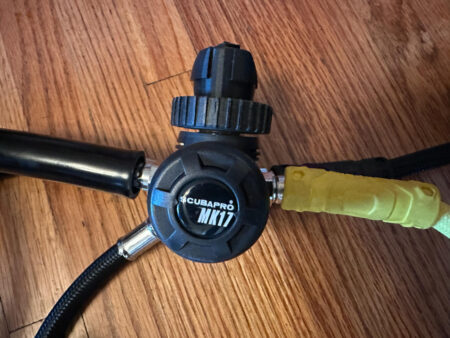 Diaphragm first stages operate on the same basic principle as piston first stages: reducing high-pressure air from your tank to an intermediate pressure before it reaches your second stage. However, instead of using a piston mechanism, diaphragm first stages rely on a flexible diaphragm to control airflow. This design creates a physical barrier between the internal components of the regulator and the surrounding water, making it particularly well-suited for diving in harsh environments.
Diaphragm first stages operate on the same basic principle as piston first stages: reducing high-pressure air from your tank to an intermediate pressure before it reaches your second stage. However, instead of using a piston mechanism, diaphragm first stages rely on a flexible diaphragm to control airflow. This design creates a physical barrier between the internal components of the regulator and the surrounding water, making it particularly well-suited for diving in harsh environments.
The diaphragm acts as a seal, preventing contaminants like sand, silt, or freezing water from entering the internal mechanism. This makes diaphragm first stages a popular choice for cold water diving or diving in conditions where debris might be present.
Just like piston regulators, diaphragm first stages feature key components:
- Diaphragm: A flexible membrane that moves in response to changes in pressure. When you inhale, the diaphragm flexes inward, opening the valve to allow air to flow from the high-pressure chamber to the intermediate-pressure chamber.
- High-Pressure Seat: Works with the valve assembly to regulate airflow and maintain a consistent intermediate pressure.
- Bias Spring: Provides tension to help control the diaphragm’s movement and ensure smooth operation at varying depths.
- High-Pressure and Intermediate-Pressure Chambers: Just like in piston regulators, these chambers manage the flow of air as it transitions from tank pressure to an intermediate pressure suitable for breathing.
- Ports: High-pressure ports connect to your SPG or dive computer, while low-pressure ports supply air to your second stage and other accessories.
Diaphragm first stages are often preferred by technical divers and those who frequent cold or challenging environments because of their sealed design, which protects internal components from exposure to water and debris. While they may have slightly more complex internal workings compared to piston regulators, their reliability in extreme conditions makes them a trusted choice for many divers.
Here’s a list of the most common piston and diaphragm first stage diving regulators:
Piston Regulators
Piston first stages are known for their simplicity, high airflow, and reliability, especially in warm water environments. Popular models include:
- Scubapro MK25 EVO/S620Ti: A high-performance piston regulator with excellent airflow and cold-water protection.
- Atomic Aquatics T3: A titanium piston regulator offering effortless breathing and corrosion resistance, ideal for travel.
- Scubapro MK2 EVO/R195: A durable, budget-friendly unbalanced piston regulator often used by dive centers.
- DGX Gears XTRA: A robust piston regulator designed for recreational and technical divers.
- Halcyon H-75P: A high-quality piston regulator favored by technical divers for its reliability.
Diaphragm Regulators
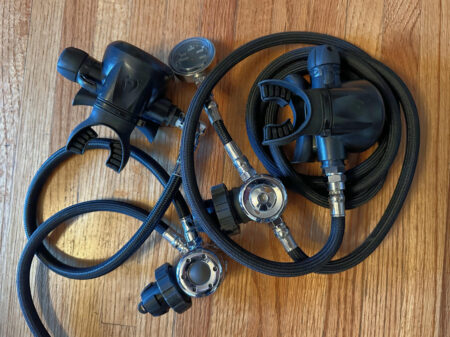 Diaphragm first stages are preferred for diving in harsh conditions, such as cold water or environments with debris, due to their sealed design. Popular models include:
Diaphragm first stages are preferred for diving in harsh conditions, such as cold water or environments with debris, due to their sealed design. Popular models include:
- Hollis 200LX + DCX: A high-performance diaphragm regulator with an over-balanced design for superior gas delivery at depth.
- Aqua Lung LEG3ND Elite: A balanced diaphragm regulator with an auto-closure device (ACD) to prevent water entry.
- Apeks MTX-RC: Built for extreme cold water diving, this rugged diaphragm regulator prevents free-flow even in icy conditions.
- Mares Abyss 22 Navy II: A balanced diaphragm regulator approved by the U.S. Navy for extreme cold water performance.
- Oceanic Delta 5 EDX: An environmentally sealed diaphragm regulator with consistent airflow and cold-water readiness.
- Scubapro MK19 EVO/G260: A diaphragm version of the MK25 designed for technical diving with enhanced durability.
But Joe… What scuba regulator is more reliable, piston vs. diaphragm?
In my opinion, I don’t think it matters. Keep in mind, I MAINTAIN MY DIVE GEAR. Even so, I have only ever had to call a dive once due to a regulator malfunction. I don’t want to name the regulator because I like it a lot, but the regulator in question was a DGX Gears XTRA that had a leaky first stage. I couldn’t fix in the field and was forced to sit the dive out. That said, I’ve had that regulator in extreme cold water and depths to over 300 feet and it is definitely a top performer.
Before getting into any more specifics, let’s dive into second stages.
Regulator Second Stages
The second stage of a scuba regulator delivers air from the first stage to the diver at ambient pressure, making it easy to breathe underwater. It’s the part that goes in your mouth. While all second stages perform this basic function, their features and designs can vary significantly, catering to different diving styles and conditions.
Key Features of Second Stages
- Balanced vs. Unbalanced: Balanced second stages provide consistent airflow regardless of depth or tank pressure, while unbalanced models may require more effort to breathe as conditions change.
- Adjustable Breathing Resistance: Many second stages include a control knob that lets divers fine-tune breathing resistance for comfort at varying depths or workloads.
- Venturi Assist: A Venturi switch helps manage airflow by reducing free-flow at the surface (Pre-Dive mode) and maximizing performance underwater (Dive mode).
- Exhaust Valve Design: Efficient exhaust valves reduce exhalation effort and direct bubbles away from the diver’s face for better visibility.
- Compact vs. Full-Sized: Compact models are lightweight and travel-friendly, while full-sized second stages often offer improved airflow and comfort during extended dives.
Popular Second Stage Models
- Scubapro S620Ti: Combines lightweight materials with adjustable breathing resistance and Venturi assist for smooth airflow at any depth.
- Atomic Aquatics TFX: Features a unique angled diaphragm for consistent breathing in any position, making it ideal for advanced divers.
- Aqua Lung Helix Compact Pro: A cold-water-rated second stage with a compact design and Comfobite mouthpiece for added comfort.
- Mares Rover 2S: A reliable, budget-friendly option with Mares’ Vortex Assisted Design for smooth airflow in recreational settings.
- Hollis 200LX: Built for technical diving, this rugged second stage offers adjustable cracking pressure and excellent performance in demanding environments.
Choosing the Right Second Stage
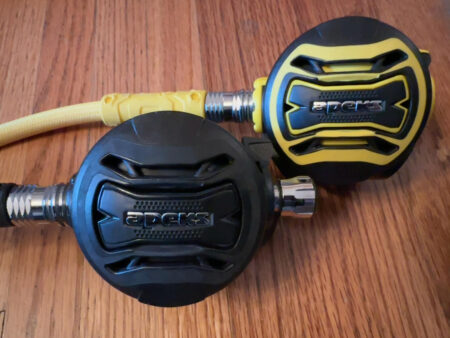 When selecting a second stage, consider your diving environment and personal preferences. Balanced models with adjustable features are ideal for deeper or more technical dives, while simpler designs work well for recreational divers in calm waters. Regardless of the model, regular servicing is essential to maintain performance and reliability.
When selecting a second stage, consider your diving environment and personal preferences. Balanced models with adjustable features are ideal for deeper or more technical dives, while simpler designs work well for recreational divers in calm waters. Regardless of the model, regular servicing is essential to maintain performance and reliability.
The Verdict: What’s the most reliable scuba regulator?
I own and dive a lot of regulators, including the arguably top-of-the-line Atomic Titanium piston regulator. I have Apeks XTX50s and Apeks XTX40 and Tek 3 regulators, ScubaPro MK17 and MK19, DGX Gears XTRA and D6, several Hollis regulators and Dive Rite XT1s for two of my rebreathers.
Best Low Maintenance Regulator: Atomic Aquatics T3
If you are a “neglect and pray” type of diver, I recommend the Atomic Aquatics T3. It is virtually immune to corrosion and has a 3 year service interval. It’s expensive, but a great choice for the maintenance challenged. The only issue I have is that titanium is NOT O2 compatible above 40% nitrox, so I don’t like it for technical diving. I do own one, though, and love it for travel, since it is amazingly lightweight.
Most Reliable Technical Diving Regulator: Apeks XTX50
I chose the Apeks XTX50 because it is virtually freeze-proof and breathes consistently to any depth. It is easy and relatively inexpensive to get serviced, and I have never once had an kind of issue with it.
Runners up include the ScubaPro MK19 and Hollis 200LX. In truth, these are all “the most reliable scuba regulators,” and you can flip a coin, or pick whatever has the best deal.
Most Reliable Warm Water Travel Regulator: Hollis 100LX / DC3
I love this regulator because it is ultra simple and very compact. A pair of these are my standard travel sidemount scuba setup. My only complaint is the port arrangement isn’t mirrored left and right, so to orient your pressure gauges, you need to set them up side by side rather than opposite one another. They are so compact, however, I don’t care.
I often dive these down to 200’ on air. I know, narcosis, MOD, etc., but in many places even nitrox isn’t available, let alone helium… Anyway, my point is the Hollis 100LX / DC3 combo performs very well to what’s arguable the absolute limit for air-depth technical diving.
My next choice is the ScubaPro MK11. I like both options because they are compact workhorses. The Hollis regulators are less expensive. Again, I have both. Generally speaking, I prefer the Apeks XTX50s, but they are quite a bit bulkier for travel.
That said, I have managed to freeze both the Hollis regulators and the MK11 in cold water, leading to free-flow. In some ways, I like the MK11 better, even for sidemount, since they are very compact. It’s really a toss up as long as freezing ins’t a factor.


